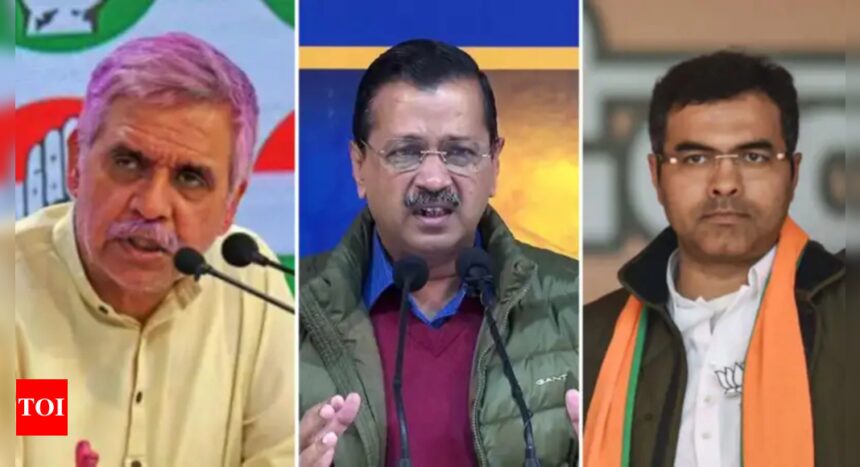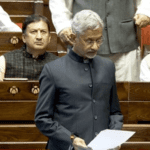NEW DELHI: Exit polls have indicated the likely conclusion of Arvind Kejriwal’s Aam Aadmi Party (AAP) decade-long governance in Delhi, with most prognosticators forecasting a BJP majority in the elections scheduled for February 5. Should these predictions prove accurate upon the vote counting on February 8, it would signify the BJP’s re-emergence in the national capital after a 27-year hiatus.
While the BJP, supported by its NDA allies, sought vigorously to engage the voters of Delhi, the INDIA bloc grappled with internal divisions, as its members AAP and Congress engaged in fierce rivalry for this pivotal contest. The campaign witnessed sharp exchanges between Congress and AAP, with Kejriwal accusing the Congress of contesting the elections to benefit the BJP, while the veteran party scrutinized AAP’s governance over the past decade in the capital.
Once a formidable political entity in Delhi under Sheila Dikshit’s leadership for a span of 15 years, Congress has seen a significant erosion of its traditional voter base due to the rise of Arvind Kejriwal’s AAP. Emerging from the India Against Corruption movement, AAP made a stunning debut in the 2013 elections, winning 28 seats largely at Congress’s expense. In 2015, AAP expanded its dominance to a staggering 67 seats, leaving Congress without representation in the assembly.
With these two parties vying against one another, a crucial question arises: Will the potential split between AAP and Congress facilitate a BJP victory, or will AAP successfully consolidate Muslim and Dalit votes to thwart the BJP’s resurgence? Notably, the BJP has opted not to field any Muslim candidates in Delhi.
Eyes are now fixed on the final results to be unveiled on February 8. Below is an analysis of how the contention between AAP and Congress may potentially aid the BJP in certain Delhi constituencies.
The Caste Question
In the previous election, AAP had established a commanding lead across all 12 Scheduled Caste-reserved seats, leaving the BJP trailing while Congress struggled to remain relevant.
Margin of Victory in 2020:
| Constituency | AAP | BJP | Congress | Margin |
|---|---|---|---|---|
| Bawana (SC) | 95,715 | 84,189 | 12,803 | 11,526 |
| Sultan Pur Majra (SC) | 74,573 | 26,521 | 9,033 | 48,052 |
| Mangol Puri (SC) | 74,154 | 44,038 | 4,073 | 30,116 |
| Karol Bagh (SC) | 67,494 | 35,734 | 3,365 | 31,760 |
| Patel Nagar (SC) | 73,463 | 42,528 | 3,382 | 30,935 |
| Madipur (SC) | 64,440 | 41,721 | 6,788 | 22,719 |
| Deoli (SC) | 92,575 | 52,402 | 2,711 | 40,173 |
| Ambedkar Nagar (SC) | 62,871 | 34,544 | 2,138 | 28,327 |
| Trilokpuri (SC) | 69,947 | 57,461 | 3,262 | 12,486 |
| Kondli (SC) | 68,348 | 50,441 | 5,861 | 17,907 |
| Seemapuri (SC) | 88,392 | 32,284 | 7,661 | 56,108 |
| Gokalpur (SC) | 88,452 | 68,964 | 2,233 | 19,488 |
Throughout the 2025 campaign, Rahul Gandhi emphasized a stronger representation for Dalits, backward communities, and tribal groups—segments that have traditionally favored Congress but have shifted towards AAP in the past two elections.
Should Gandhi’s focus on caste resonate with significant backing from these targeted voters, the division of votes between AAP and Congress could substantially influence results, particularly in districts where the margins of victory were marginal. Ultimately, this may tip the scales in favor of the BJP.
In Bawana, AAP triumphed by a margin of 11,526 votes, while Sultan Pur Majra displayed one of the most significant disparities. Similarly, Mangol Puri (30,116 vote difference), Karol Bagh (31,760), and Patel Nagar (30,935) reflect the competitive landscape. Congress maintained a narrow disadvantage in Seemapuri (56,108 votes) and Gokalpur (19,488 votes).
There are 12 districts featuring a substantial Muslim voter population; traditionally, these constituents have not favored the BJP, making AAP and Congress their likely options. The consolidation or fragmentation of these votes may play a critical role in determining the outcome of this high-stakes election.
Muslim Voters Hold the Key?
The voter turnout within Muslim-majority areas during the 2025 Delhi Assembly elections showcased significant participation. For example, Seelampur noted a turnout of 68.70%, closely followed by Mustafabad at 69%, while Sultanpur Majra (68.30%) and Babarpur (66%) also recorded impressive figures.
Margin of Victory in 2020:
| Constituency | AAP | BJP | Congress | Margin |
|---|---|---|---|---|
| Seelampur | 72,694 | 35,619 | 20,207 | 37,075 |
| Matia Mahal | 67,282 | 17,041 | 3,409 | 50,241 |
| Ballimaran | 65,644 | 29,472 | 4,802 | 36,172 |
| Okhla | 130,367 | 58,540 | 5,123 | 71,827 |
| Chandni Chowk | 50,891 | 21,307 | 3,881 | 29,584 |
| Seemapuri (SC) | 88,392 | 32,284 | 7,661 | 56,108 |
| Sultanpur Majra (SC) | 74,573 | 26,521 | 9,033 | 48,052 |
| Badli | 69,427 | 40,333 | 27,483 | 29,094 |
| Babarpur | 84,776 | 51,714 | 5,131 | 33,062 |
| Mustafabad | 98,850 | 78,146 | 5,355 | 20,704 |
| Karawal Nagar | 88,498 | 96,721 | 2,242 | 8,223 |
| Shakur Basti | 51,165 | 43,573 | 3,382 | 7,592 |
Historically a Congress bastion, Seelampur, which has 57% Muslim voters, was won by AAP in both 2015 and 2020. This election sees AAP’s Chaudhary Zubair Ahmad competing against Congress’s Abdul Rehman, a current MLA who recently transitioned from AAP to Congress.
Additionally, Congress has emerged as a significant contender against AAP in Muslim-majority districts such as Matia Mahal (60% Muslim voters), Ballimaran (50%), Okhla (52%), and Chandni Chowk (30%).
Clearly, numerous districts will remain focal points of scrutiny for all involved parties tomorrow when votes are tabulated. The actual results will ultimately reveal whether Congress has impacted AAP’s chances in these elections.










